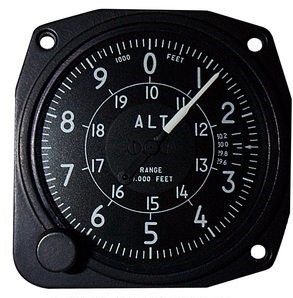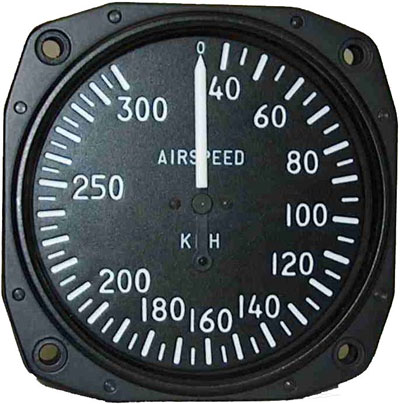Knowing your altitude is critical - unless you want to meet the ground unexpectedly!
Altitude was measured in Feet above Sea Level. In military communications altitude was often referred to in "Angels". Angels 10 would mean 10000 feet above sea level.
An aircraft's altimeter indicates the current altitude.
Very Important! Most airports are not located at sea level. A pilot must know the elevation - or ground attitude - of the airport he wants to land at. For example,
the airport at Base Borden is 250 feet above sea level. That means when an aircraft lands, the altimeter shows 250 feet - NOT zero. The airport at Camp Shilo, Manitoba
is 785 feet above sea level, and the airport at Calgary, Alberta is 3430 feet above sea level. Out on the prairies, trainee pilots are often shocked to see the ground
coming up quickly, when they think they still have 2000 or 3000 feet of altitude.

Air Speed
Airspeed is measured in "Knots" - just like the Navy. One knot equals 1.85 kph. An airspeed of 200 knots equals 370 kph. Your airspeed depends on a number of factors:
- the pitch or angle of your propeller blade
- your engine rpms - determined by your throttle settings
- whether you are flying level, climbing or diving
- whether your flaps are extended
- whether you remembered to raise your undercarriage/landing wheels (rookie mistake!)
- your aircraft's angle of attack: nose up, level, or tail up
- your aircraft's altitude ( planes fly faster at high altitudes with less wind resistance)
- and the effect of wind on your aircraft.
You have an Air Speed indicator among your dials but this is not always accurate. It measures the speed of
the aircraft relative to the air around it. However, a strong headwind will slow you plane's actual speed while a strong tailwind will increase your
aircraft's actual speed. There are a number of speeds you have to be aware of - the lowest speed that will keep your aircraft flying, known as the "stall speed",
the recommended flying speed for good fuel efficiency - known as the "cruising speed", the maximum emergency speed without damaging the engine - maximum speed,
and the maximum dive speed before the plane suffers structural damage. Aircraft rarely use their maximum speed. It burns up too much fuel too quickly and wears
out the engine. Most bomber flights are made at cruising speed.

 |